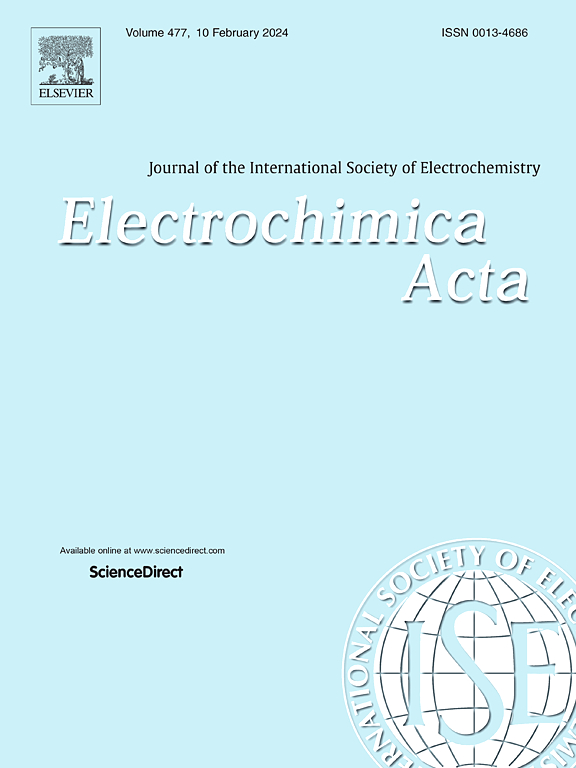Enhanced sodium storage in MXene transition metal chalcogenides anode through dual molten salt etching
IF 5.5
3区 材料科学
Q1 ELECTROCHEMISTRY
引用次数: 0
Abstract
Referred to as potential options for anodes in sodium-ion batteries, transition metal chalcogenides (TMCs) exhibit unique electronic and structural characteristics. However, the limited electrical conductivity inherent in them poses a hindrance to electron transport, while their tendency to undergo volumetric expansion during cycling exacerbates structural instability, thereby imposing constraints on practical applications. Herein, a dual molten salt etching strategy followed by a sulfidation-selenidation process was employed to anchor multi-component sulfides FeS2/NiS and FeSe/NiSe onto conductive Ti3C2Tx MXene, achieving superior sodium storage performance. Owing to the enhanced Na⁺ and faster kinetics of electronic transport, mechanical strain is effectively reduced, and strong covalent interactions are formed at the interface, significant enhancement in the cycling stability is observed for the anodes of Ti3C2Tx@FeS2/NiS and Ti3C2Tx@FeSe/NiSe (with specific capacities of 309.4 and 162.6 mAh g−1, respectively, after 1000 cycles at 5 A g−1, with a former retention capacity rate that can reach as high as 87.8 %) and exceptional rate performance (252.1 and 207.8 mAh g−1, respectively, at 8 A g−1). Furthermore, full cells assembled by pairing Ti3C2Tx@FeS2/NiS and Ti3C2Tx@FeSe/NiSe with Na3V2(PO4)3 cathodes also demonstrate excellent cycling performance, with both configurations achieving up to 500 cycles. The suggested approach enables efficient utilization of byproducts from Lewis acidic etching, expanding possibilities for synthesizing high-performance anodes in sodium-ion batteries consisting of MXene and TMCs.
通过双熔盐蚀刻技术提高 MXene 过渡金属卤化物阳极的钠存储能力
作为钠离子电池阳极的潜在选择,过渡金属瑀(TMC)具有独特的电子和结构特性。然而,它们固有的有限导电性阻碍了电子传输,而在循环过程中体积膨胀的趋势又加剧了结构的不稳定性,从而对实际应用造成了限制。在本文中,我们采用了先熔盐蚀刻再硫化-软化的双重策略,将多组分硫化物 FeS2/NiS 和 FeSe/NiSe 固定在导电的 Ti3C2Tx MXene 上,实现了卓越的钠存储性能。Ti3C2Tx@FeS2/NiS 和 Ti3C2Tx@FeSe/NiSe 阳极的循环稳定性显著提高(比容量分别为 309.4 和 162.6 mA)。在 5 A g-1 下循环 1000 次后,比容量分别为 309.4 mAh g-1 和 162.6 mAh g-1,前者的容量保持率高达 87.8%)和优异的速率性能(在 8 A g-1 下,比容量分别为 252.1 mAh g-1 和 207.8 mAh g-1)。此外,将 Ti3C2Tx@FeS2/NiS 和 Ti3C2Tx@FeSe/NiSe 与 Na3V2(PO4)3 阴极配对组装而成的全电池也表现出卓越的循环性能,两种配置均可实现多达 500 次循环。所建议的方法能够有效利用路易斯酸性蚀刻的副产品,为合成由 MXene 和 TMC 组成的钠离子电池中的高性能阳极提供了更多可能性。
本文章由计算机程序翻译,如有差异,请以英文原文为准。
求助全文
约1分钟内获得全文
求助全文
来源期刊

Electrochimica Acta
工程技术-电化学
CiteScore
11.30
自引率
6.10%
发文量
1634
审稿时长
41 days
期刊介绍:
Electrochimica Acta is an international journal. It is intended for the publication of both original work and reviews in the field of electrochemistry. Electrochemistry should be interpreted to mean any of the research fields covered by the Divisions of the International Society of Electrochemistry listed below, as well as emerging scientific domains covered by ISE New Topics Committee.
 求助内容:
求助内容: 应助结果提醒方式:
应助结果提醒方式:


